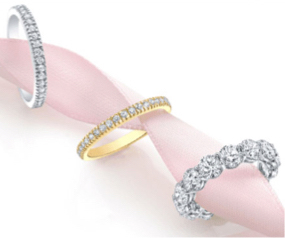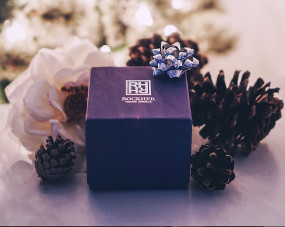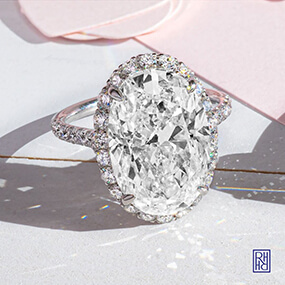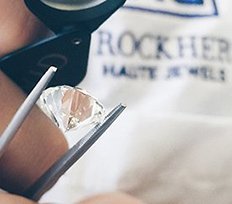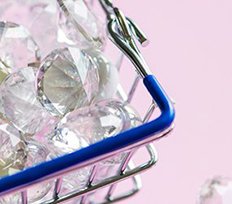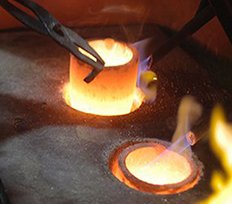When would you be happy to receive a D grade? When you’re grading the color of your diamond, of course! D is the highest colorless diamond grade and the ultimate colorless gem. D color diamonds are the pinnacles of icy colorless perfection. Why do we say colorless diamonds and not white diamonds? Colorless diamonds are transparent like water, not reflective like a white paint chip.
Less than one percent of the diamonds sold for engagement rings each year are colorless enough to be receive a GIA D color grade. Rare and refined, D color grade diamonds are the top of the standard GIA diamond color scale which goes from D, for completely colorless, to Z, for diamonds that are light yellow or brown. (Fancy colored diamonds, which have more noticeable color than Z diamonds, have their own separate color grading scale that describes their hue as well as the intensity of the color.)
The D-to-Z diamond color scale and the universal language of diamond color was created by the Gemological Institute of America in the 1950s. GIA created the GIA diamond color grading system to replace the descriptive terms that diamond dealers used to describe color. GIA knew that an objective standard for diamond grading, with defined steps between each color grade, would build trust in diamond value.
Completely colorless diamonds, what we now know as D color diamonds, were called “Jager diamonds” after a mining source that had produced very colorless gems. The legendary historical Golconda mine in India is also known for having produced completely colorless diamonds so “Golconda diamonds” are also a colorless.
 Image: 3ct D Color, IF Clarity Diamond
Image: 3ct D Color, IF Clarity DiamondWhy did GIA choose D as the best color grade rather than A or AAA or five star or some other superlative? GIA wanted to make sure that its scale wasn’t mistaken for individual dealer rating systems in use at the time. They knew that no one was crazy enough to use a D grade as a sales pitch for their diamonds so there was no danger that it would be mistaken for any other color grading system.
Today, no matter what language you speak, you know that a D-color diamond is the best diamond color, as the GIA International Grading System has become the universal language of diamond quality.
Before a diamond officially becomes a D-color diamond, it has to be graded by the GIA. Diamonds are graded face down so that the eye can focus on the body color of the gem without distraction from its brilliance and dispersion.
Since color depends on the viewing environment, graders use a standard light source and completely colorless background when grading diamond color and always look at diamonds with the light at the same angle. To standardize the perception of the amount of color perceived, graders compare the color of a diamond to a set of diamond master stones. At GIA, at least two graders submit color grades (without knowing the other grader’s opinion.) If they disagree, a senior gemologist will also grade the gem. The color grade is determined when enough graders agree (the number depends on the size of the diamond.)
But what does D color mean really? It means that a diamond appears colorless when placed upside down when viewed next to the D color diamond in the masterset. It’s much easier to see slight differences in color next to other diamonds so graders use comparison to judge color.
In addition to their absence of color, many D color diamonds are chemically more pure than other diamonds, with fewer trace elements incorporated into the carbon of their atomic structure. Often D-color diamonds are type IIa, a rare category of diamonds that contain almost no nitrogen. Diamond type is a simple way of classifying diamonds based on their chemical composition and atomic structure. (Most diamonds used in jewelry are type Ia, which contain traces of nitrogen. These “cape” diamonds range from colorless to light yellow, since nitrogen absorbs blue wavelengths and imparts a yellow tint.) Type IIa diamonds are very rare, making them appeal to collectors.
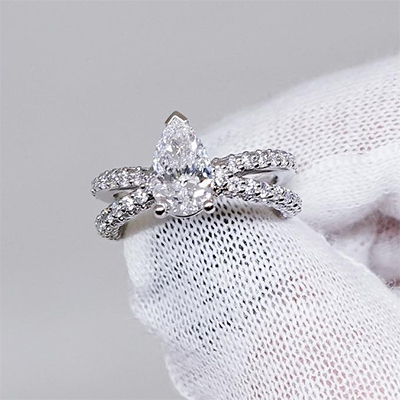 Image: Ring set with a D color pear shaped diamond
Image: Ring set with a D color pear shaped diamondDiamond type is generally not listed on a GIA grading report unless requested: it requires using a Fourier transform infrared (FTIR) spectrometer to measure the absorption of electromagnetic radiation of the diamond. (You have to pay extra for the test.)
Will you be able to tell that your diamond has a D-color grade when you wear it? If your diamond is set in platinum or another white metal like palladium or a bright white gold, even diamond professionals will be able to see that your diamond is colorless but probably not its exact grade.
The difference that D color makes in your diamond’s appearance is more subtle than the cut quality or carat weight of your diamond. D color diamonds are valuable because they are rare, not because they are noticeably more beautiful than other colorless diamonds.
Is it worth it to buy a D-color diamond? Only you can say. Certainly D-color diamonds wouldn’t cost as much as they do if there weren’t people who were willing to pay a premium to buy them.
WHAT ROSI RECOMMENDS
If you are buying a D-color diamond, you are buying a rare investment-grade diamond and paying a significant premium for it. D-color diamonds, especially in large carat sizes, will sell for a multiple of other colorless diamonds simply because of rarity. If you do decide on a D color diamond, make sure that all other aspects of your diamond’s quality are also investment grade: the clarity should be VVS2 or higher, the cut should be exceptional (hearts and arrows or excellent), fluorescence should be none to faint, and your diamond should be set in platinum. Anything less and you are buying a diamond that’s good but not really exceptional. You would be paying a significant premium for a gem that isn’t the best. Why not buy a bigger gem that is just as beautiful without the pedigree? Bottom line? Don’t invest in D-color above other factors.
How does ROSI know diamonds so well? We trained her with dozens of professional diamond buyers. We asked them which diamonds among thousands they would buy for themselves or their daughters. ROSI calculated how they balanced more than 30 individual quality factors and applies those lessons to sift through all the grading reports of all the diamonds available on the market to pick the best combination of quality and value. With ROSI, you’ll find that brilliant needle in the haystack every time.


